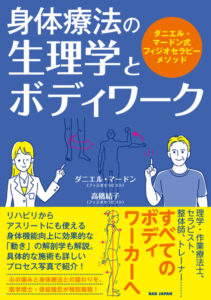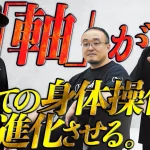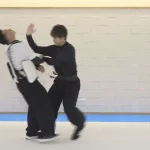【Exploring the spirit of the Ryukyu】Series 12 (HIDEN 04/2024)「YAGI MEITATSU SENSEI」

【Exploring the spirit of the Ryukyu】Series 12 (Translated from “HIDEN” April 2024)「YAGI MEITATSU SENSEI」
Interview/text: Daniel Mardon
Photography/Translation ◎Yuko Takahashi

The Yagi Dojo, the headquarters of the International Meibukan Goju-Ryu Karatedo Federation, is located in Kume, Naha City, which has a deep history with China.
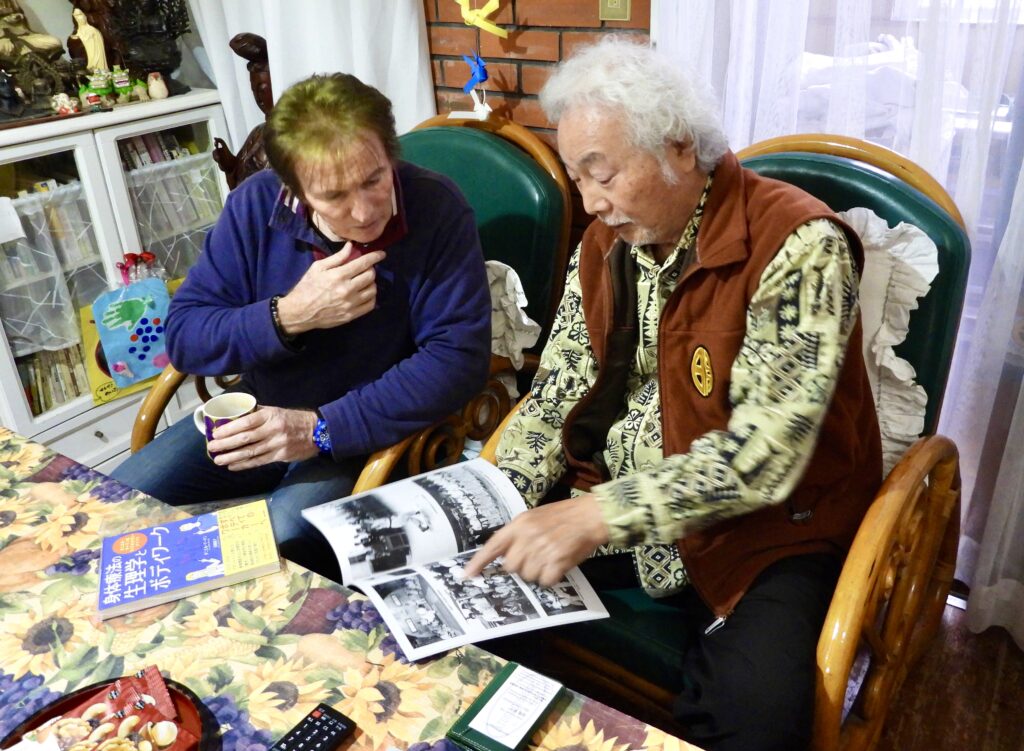
Yagi Meitasu Sensei (right) explains the history of Goju-ryu. Daniel Sensei admires the precious photos.
Let’s witness again, how history can be connected to geography and vice-versa and how was life in “Kuninda”; the old name for Kume or Kumemura?
In the past, Naha City was a “浮島 “Ukishima” [this kanji 浮 meaning “floating” and this one 島 “island”] in a bay and was therefore surrounded by the East China sea. In one corner of this “Naha-island”, Kume Village had a population that mostly came from China.
Indeed, Kume Village was the home to a group of professional scholars, scientists and bureaucrats sent by the emperor of China’s Ming Dynasty in 1392. They came from Fujian and inspired the surname of the “36 families of Kume”, which were in fact more like 700. Thus, they were involved in the diplomacy and trade of the Ryukyu Kingdom, and had a great influence on politics, education, culture and some of them are said to have knowledge of martial arts.

Kume village main street


Fukushuen Garden

In 11/2022 this beautiful granit carved stelae was installed in Matsuyama Park to honor Yagi Meitoku Sensei

Boat representing the 36 families from Fujian
Yagi Meitatsu Sensei is the 21st generation descendant of a family ancestor whose name was Teigisai 鄭義才. The 9th generation descendant was Teidojanaue Katarizan 鄭迵謝名親方利山は; a very prominent politician of the Ryukyu Kingdom who defended Ryukyu during the invasion by the Satsuma feudal clan in 1609. After refusing to sign the petition for the annexation of the Ryukyu to Japan he was beheaded in Satsuma. (See his picture)
A bridge named “Chōkōtei” was built in 1451 to connect the floating island of Naha with Tomari Sogenji; a place that I particularly like and mention in my articles. This resulted in opening up transportation links with Shuri and allowing Tomari and Naha Port to prosper.
The “Meibukan” is adjacent to the exotic Fukushuen Garden and Matsuyama Park and as we arrive, the winter sun is setting over the historic townscape.
We are therefore meeting today the second generation Soke; Yagi Meitatsu Hanshi 10th Dan.
A solid man opens the door and we immediately recognize Yagi Meitatsu Soke. We didn’t expect him to be so tall…! He invites us to sit down comfortably in his home. Yagi Sensei has prepared an excellent pot of coffee with cookies. He is extremely nice and it feels like we are visiting a family member. After a precious couple of hours of learning tons of stories and anecdotes, it is time to go up to the adult class upstairs on the 4th floor. The children’s class is just ending and the number of young Karateka lined up in “seiza” for the final “Rei” is impressive.
Meitatsu Soke appears in an immaculate Karate-Gi with a silky purple vest and as always, when a Hanshi penetrates in his Dojo, time and space seem to freeze for a few seconds. His son, Akihiro Hanshi 9th Dan, is in charge of most of the classes. He is as tall as his Dad!
I had heard from American friends that training at the Meibukan is tough and I have the feeling that it will be hard. Tonight, they are preparing for a competition and since I don’t want to slow the class down, I manage to humbly stand in the back. It starts very fast and “Kihon” is warming up. “Kote-Kitae” (forearms hardening), “Kake-Te” are part of the “Hors d’oeuvre” and it is followed by super rough 約束組手 “Yakusoku Kumite”(“San-bon/Go-hon-Kumite”). I learned that this is the specialty of the Dojo and I am having a painful moment since we need to take turns until we practice with everybody. The girls hit as hard as the boys and I end-up with both forearms covered with bruises and my right forearm bleeding a bit…

Ryukyu Kingdom politician Teidojanaue Katarizan was the 9th generation descendant of Teigisai, who had the surname of Kume Sanjuroku. Meitatsu Sensei is the 21st generation descendant of the whole lineage.

BIOGRAPHY
Yagi Meitatsu Soke 10th Dan Hanshi (1997)
Born on July 7, 1944 in Kume, Naha City.
Second Soke of International Meibukan Goju-Ryu Karate Do Federation Headquarters/Okinawa Traditional Karate Kobudo International Training Center
President of the Okinawa Karate Kobudo Federation.
Vice president of the Okinawa Traditional Karate Promotion Association.
Vice-chairman of the Okinawa Traditional Goju-ryu Karatedo Federation.
Teigisai Monchukai Chairman.
Vice-chairman of the Okinawan traditional “Take no kai (Bamboo Society)”.
Chairman of the Ryukyu Chunji- Association.
Chairman of Kume Doshinkai.
Okinawa Prefecture Cultural Merit Award (Reiwa 5).
Naha City Karate/Kobudo Achievement Award (Naha City Athletic Association). Okinawa Karatedo Kobudo Achievement Award (Ryukyu Shimposha).
Today, we will be visiting the headquarters of the International Meibukan Goju-Ryu Karatedo Federation. This legendary Dojo, located in the Kume district of Naha, was established in 1957. In 1984, the Dojo was moved from the 1st floor to the 4th floor, after the reconstruction of the building. However, Yagi Meitoku Sensei (1912-2003) had started his own Goju-Ryu Dojo earlier in Daido Naha, in 1952. Yagi Meitoku, first generation Soke; father of Yagi Meitatsu Sensei, has been bestowed the title of 沖縄県指定無形文化財保持者
(Intangible Cultural Property Holder) by Okinawa Prefecture.
(1-) How did you start karate?
I remember that my father told me to give it a try, and that’s when I started. I was about 5 years old and I practiced with adults six days a week except Sunday.
At that time, it was chaos; everyone had lost their homes in the war and was scattered. We were living in Daido, Naha. Around 1952, my father opened “Aozora Dojo” (Blue-sky Dojo) in a vacant lot next to our house and began teaching Karate. Since it was outside and the sky is not always blue, we took a break when it rained.
A few years later, we were able to return to the land we lived on before the war in Kume and we built a house with a Dojo at this very place.

Meitatsu Sensei’s favorite kihon-kata Sanchin kamae.

Meitasu Sensei teaches Daniel the kata “Sepai” (18 hands).

Yagi Sensei correcting position
(2-) What are the characteristics of your school (Dojo)?
On the physical plan, we do a lot of “Kansetsu waza” (joint techniques) and a lot of close combat. On the mental plan, we value the spiritual training of Martial Arts Karate.
The name of the Dojo “Meibukan” alludes to “Mei” 明 (clear & coherent) and “Bu” 武 (martial). Here the “Bu” is not the warrior version of that Kanji. The left bottom part of that Kanji 武 was originally said to represent “legs” that carry the “weapon” (sword shape on the right) and it used to signify “Go to fight”.
However there is also another interpretation for the left part of that Kanji (legs) which is “Stop” and associated with the sword, it means “Stop fighting”. In another word, this signifies that you can “Win without fighting”… This reflects exactly my father’s desire to name his Dojo Meibukan as his highest ideal.
The motto of the Dojo is the favorite phrase used by my father’s Shisho; Miyagi Chojun Sensei: 奥妙在錬心 “Oumyōzairenshin” (To deepen the ougi奥義(mystery), you must first train your mind.

Akihito Kaicho teaching “Yakusoku kumite”. Here are the “Jodan tsuki” and “Jodan uke” versions. According to Meitatsu Sensei, in the past, people practiced Karate late at night to avoid being seen by others, and even practiced in graves.
(3-) What is your favorite Waza and Kata?
I don’t play matches, so I don’t have any special skills (lol). People sometimes ask me, “How many trophies do you have?” I answer; “I don’t have any.” Sometimes they ask; “Have you ever lost?” Many people are surprised if you answer; “I’ve never lost, but I’ve also never won…!” What I mean by “I’ve never played a match” is that I am a Martial Arts Karateka.
My favorite Kata used to be “Sepai”. It has changed with age, and now it is “Tensho”.
NOTE: Okinawan Karate Kata were written in Katakana after listening to their Chinese pronunciation “On yomi” (sound). Therefore, for the same Kata, a character can be different and can make a change in the name.
Sometimes, the name has completely changed and it is the case for “Suparinpei” (壱百零八手) which was originally called “Bechurin”.
The true pronunciation for its Katakana is “イーパイリンパー” (ee-pa-i-rim-paa). “イー” (ee) stands for 1, “パイ”(pai) would be 100, “リン”(rin) would be 0 and パー(paa) would be 8. However, people heard it as “Suparinpei”…
(4-) What is your most impressive memory of your Sensei/(Shisho)?
My Shisho is my father, Yagi Meitoku Hanshi. At home, he was my father, but at the Dojo, he was my teacher, so it was difficult to talk to him, especially when I was a child, it was nothing like in a regular family.
On my days off, he used to take me to amusement parks, go fishing, and go to historical dramas, but his best Deshi/disciple, Tamaki Yushun Sensei, often took me fishing and bought me sweets.
Being the Deshi of Miyagi Chojun Sensei, my father often did the same with his eldest son and took him out to play. Chojun Sensei similarly didn’t go out much with his children.
When I was in my third year of high school (17-18), my father received a letter from one of his American Deshi, inviting him to a Dojo in America for guidance. My father was busy at the time and he asked me to go.
I had a vague idea about going to a university in mainland Japan, so I decided to take the plunge and go to America. That experience has been a huge plus in my life, and I am truly grateful to my father.
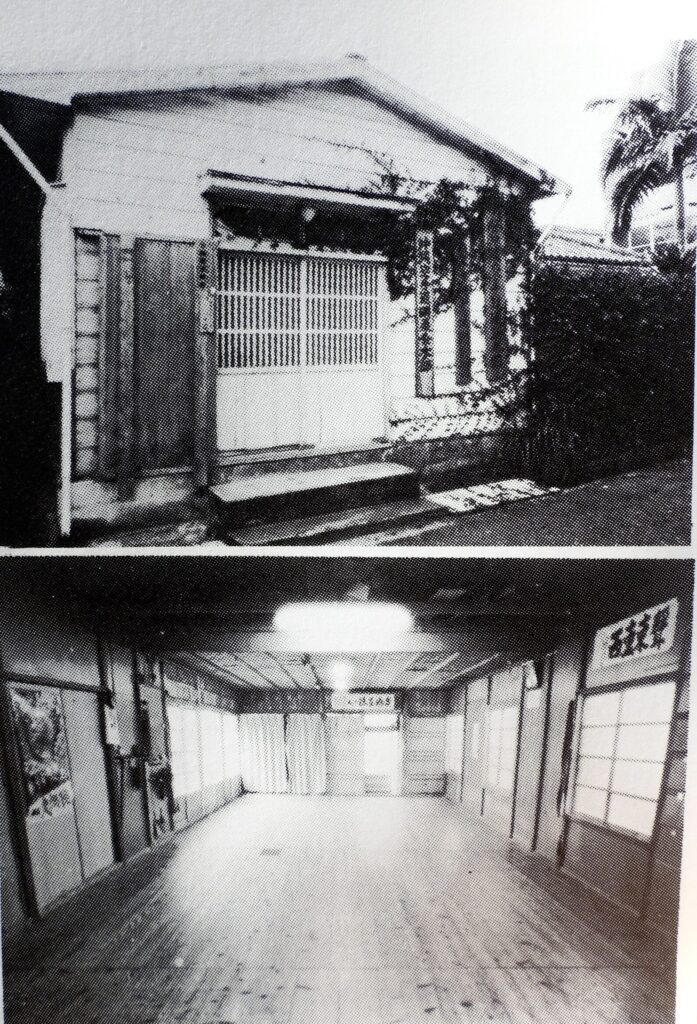
The first Meibukan Honbu Dojo was a single floor construction built in 1957. The current Dojo is at the same location.

Yagi Meitoku Sensei’s “kouke” pose from Kata “Suparinpei”.
(5-) What is the difference between Okinawa Karate and mainland Karate?
It’s what makes the difference between Budo-Karate and Kyogi (competitive) Karate.
Competitive Karate-kumite is what we commonly call a “match” and if you lose, you can try again at the “next year’s tournament”
A street fight cannot be tried again… This is Budo-Karate. There are no referees, no doctors, no rules. The enemy is not necessarily a Karate practitioner, but may also be a wrestler or a kickboxer. Moreover, it can also be not just one person, but multiple people, and they may be carrying knives or guns.
Additionally, fighting outside depends on the weather, such as how to fight when it’s raining, windy, muddy, on pavement or among stones. If you make even one wrong decision, you could be killed. Karate and especially Okinawan Budo-Karate, takes all this into consideration.
Since it’s a self-defense technique, it doesn’t really matter who is better at it.
(6-) Do you often teach to foreigners?
There are approximately 100 branches of the Meibukan Dojo in 30 countries around the world, and we travel overseas to teach two or three times a year.
When I lived and worked overseas for about 16 years, I had the opportunity to teach Karate to local employees and police officers, and my relationships with them deepened.


Kihon
(7-) What do you think about the globalization of Karate?
I think that’s a good thing. Karate is the pride of Okinawa.
Let’s talk about “The Viper and the Cow.” Even if a poisonous snake and a cow drink the same water, the poisonous snake releases poison and kills people, while the cow produces milk and is useful for people. Even if the teachings are the same, the outcome and therefore the future will be different. It teaches us not to be poisonous snakes, but rather to be cows.
We also teach to children 礼儀 Reigi (manners) so that they respect their elders and have a feeling of nurturing their 後輩 kōhai (juniors). I wish Karate can serve as a place for human development and to spread throughout the world.
(8-) What do you think about Karate becoming a competitive sport, including the Olympics?
Japanese Karate expects gold, so there are some athletes who cry even if they win a silver medal.
Isn’t it great to be number 2 in the world? I think competitive Karate also teaches spiritual things, but I feel that the ultimate goal is to win a medal or to win a competition.

Daniel jokes about his bruises with Yagi Sensei

Yuko Sensei comparing her hand with Yagi’s Sensei
(9-) What does today’s Karate mean to you?
Through Budo-Karate, we convey the importance of spiritual training. Human life is limited, so what we should do and what we should leave behind is very important.
There is a proverb that says, “A dog protects the night, a bird protects the dawn, and a man protects the 道 “michi” (the path, the road, the way)
It is the mission of the people/humans to protect the “michi”.
Budo-Karate begins with “uke”. In the traditional “salute pose”, the right hand is a fist and the left hand is wrapping it and holding it down, indicating that there is no intention to fight.
If you had to fight, a normal teacher would teach you how to win, but here we rather teach “how not to lose”. Winning and not losing seem similar, but they are in fact different in essence.
Chojun Miyagi Sensei liked the maxim “流水は先を争わず/Ryusui ha saki wo arasowazu. (Don’t fight to win..!) It is better to stand in the middle without fighting. Rivers simply aim for the ocean without rushing or fighting.
川の水は、急がず、争わず、ひたすら大海を目指す、という意味
(10-) How do you envision the future of Karate?
I think Budo-Karate and Kyogi (competitive) Karate will coexist for the foreseeable future and for the next 40 to 50 years.
A reasonable foreigner should do competitive Karate while doing Budo Karate. Ultimately, I hope that the world can become peaceful through Karate. All traditional Okinawan Karateka feel the same way.
I also feel that Okinawa Karate cannot be easily unified with the other forms of Karate.
(11-) Do you have any message for the world?
I pray that Karate will create bonds with people, regardless of their religion or skin color. Karate makes people happy and brings peace to the world.
(12-) What does “Karate” mean to you?
Karate is part of life. I’ve been doing it since I was 5 years old. My disciples, acquaintances, and friends around the world are my greatest asset.
Daniel sensei’s conclusion:
The historical connection between the people who came to Kume from China and their influence on the ancient Ryukyu Kingdom is very interesting. The spirit of the Naha-Te/Goju-Ryu reflects a certain sophistication with its emphasis on breathing techniques, foot positioning and its concept of hard and soft which relates to the Yin & Yang.
I was surprised by the super tough 約束組手 Yakusoku Kumite” (“Sanbon/Gohon Kumite”) which seems to be the specialty of the Meibukan. The girls hit just as hard as the guys and I end-up with both forearms covered with bruises. lol. Great work!
It was an amazing experience and as I always say; each Dojo in Okinawa has its own special secrets…. Domo arigato Yagi Sensei.

Karate stance: Daniel Sensei (left), Meitatsu Sensei (center), and Meitatsu Sensei’s eldest son, Akihito Kaicho (right)

With the students of the Yagi Dojo.

Daniel Mardon; the Karateka-Therapist
Creator of Aromapressure® method and physiotherapist with a valid US license, Daniel Mardon was born in Paris. One of his specialties is to teach and to perform lymphedema and subcutaneous tissue-damage care, after radiotherapy for cancer patients at medical institutions and subcutaneous tissue-circulation stimulation before and after surgery.
He was also a therapist for two famous soccer teams in Paris. Since 2005, he has focused on producing top-class hotel spas in Japan, as well as physiotherapy education and awareness-raising activities for health care professionals. Author of several books, among his major publications includes “The Physiology and Bodywork of Physical Therapy ” (Published by BAB Japan) and DVD “Daniel Mardon Aromapressure® Method ” (Pony Canyon). He regularly appears on television and radio shows, and has featured in numerous media publications.

